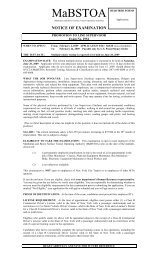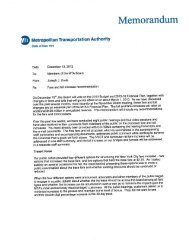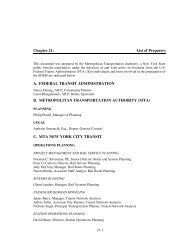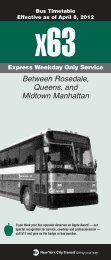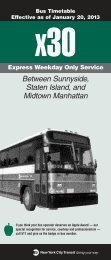Greening Mass Transit & Metro Regions: The Final Report - MTA
Greening Mass Transit & Metro Regions: The Final Report - MTA
Greening Mass Transit & Metro Regions: The Final Report - MTA
Create successful ePaper yourself
Turn your PDF publications into a flip-book with our unique Google optimized e-Paper software.
should not be missed. <strong>The</strong> Adaptation Priority Task Force should act on a fast track and must not be held back by the<br />
more fundamental and time-consuming initiatives proposed under Recommendations 2 to 5, although APT must establish<br />
a strong working liaison with these other initiatives.<br />
Recommendation 7: Assign an <strong>MTA</strong>-Internal Adaptation Team (AT)<br />
<strong>The</strong> <strong>MTA</strong> should assemble a designated internal Adaptation Team (AT). This can be done immediately and should be<br />
completed by March 2009. <strong>The</strong> AT has a twofold purpose. First, it should represent the <strong>MTA</strong> outside its institutional and<br />
regional jurisdictions in efforts to determine policies, performance standards, research projects, and so forth that serve the<br />
needs of diverse stakeholders in the region. <strong>The</strong> second objective of the AT will be to perform a much-needed interface<br />
and educational role among the <strong>MTA</strong> agencies. <strong>The</strong> AT should partner with experts in academia, professional organizations,<br />
and technical fields for these “in-reach” efforts. <strong>The</strong> AT will need an operating budget and established goals for its activities<br />
not later than mid-2009. It should be operative for a period of at least three years and be reviewed in its third year for<br />
possible continuation depending on its achievements and effectiveness, and on the challenges that still need to be tackled.<br />
Recommendation 8: Prepare Adaptation/Mitigation Cross-Impact Checklists<br />
Each mitigation project the <strong>MTA</strong> undertakes needs a checklist indicating how it affects adaptation according to short- and<br />
long-term horizons. Each adaptation project needs a checklist to show how it enhances or hinders mitigation and energy<br />
conservation efforts and improves environmental performance. Depending on identified adverse cross-impacts, the project<br />
designs and implementation plans must seek modifications to strike a well-justified, documented balance if the outcomes<br />
are still mutually incompatible and no viable alternatives can be found.<br />
Recommendation 9: Implement Climate Adaptation Resiliency Evaluation Procedure (CARE Trigger Elevation)<br />
By the end of 2009, the <strong>MTA</strong> should establish, preferably in concert with local governments, a procedure called CARE<br />
(Climate Adaptation Resiliency Evaluation). It would be triggered when any new projects or major alterations are undertaken<br />
where critical structural components are located in present or potential coastal surge flood zones. <strong>The</strong> procedure would be<br />
triggered at a given Elevation X to be formulated, probably at not less than 15 feet above the mean-lower-low-watermark<br />
(MLLW), for example in the year 2000 at the Battery tide gauge. A trigger elevation substantially higher than 15 feet, at<br />
least for some regions of high risk exposure, may be advisable based on precautionary principles. <strong>The</strong> <strong>MTA</strong> should promote<br />
the development of CARE procedures and guidelines internally and externally, recommend its usage in Smart Growth/TOD<br />
projects, and should definitely adopt the CARE procedures for all <strong>MTA</strong> projects and in-house planning.<br />
Recommendation 10: Provide Visible <strong>MTA</strong> Leadership on Climate Change Issues<br />
<strong>The</strong> <strong>MTA</strong> should assume a highly visible leadership role in tackling the enormous challenges of adaptation. It should take a<br />
strong stand on climate change issues on the local, state, federal, and even global levels. It should be consistent and forceful<br />
in pursuing adaptation and mitigation policies, becoming a national voice on behalf of the country’s vital infrastructures,<br />
particularly in urban centers. It should seek institutional credibility through strong implementation of such policies, while<br />
balancing limited resources in pursuit of either mitigation or adaptation strategies. <strong>The</strong> <strong>MTA</strong> has made a clear start by<br />
enlisting the Blue Ribbon Commission on Sustainability and the <strong>MTA</strong>. This marks an important beginning. Achieving<br />
adaptation measures for the New York metropolitan region will demand the energy, innovation, and leadership characteristic<br />
of New Yorkers. <strong>The</strong> <strong>MTA</strong> can and must lead in preparing for this unavoidable and critical challenge.<br />
SUMMARY FINDINGS AND NEXT STEPS<br />
Without an adequate investment in adaptation measures, climate change will have even greater adverse impacts on the<br />
<strong>MTA</strong>’s vital infrastructure, operations, and revenue streams in the future. <strong>The</strong> chief risks to the metropolitan region and the<br />
<strong>MTA</strong> service area stem from more extreme heat and precipitation events, coastal storms and storm surges, flooding, and,<br />
in the longer term, rising sea levels. Preparation will mean a forward-looking plan for necessary redesigns, construction<br />
programs, and changes to operational procedures, including emergency preparedness. As such, the <strong>MTA</strong> will need to<br />
institutionalize adaptation measures over a wide range of operations and facilities. <strong>The</strong> most immediate threat will come<br />
from increased storm surges and SLR encroaching on existing facilities, especially those below sea level.<br />
<strong>The</strong> <strong>MTA</strong> should have a climate change adaptation master plan in place by 2015, one that includes realistic time tables<br />
and financing options. As it assesses the 10 recommendations above, the <strong>MTA</strong> should proceed to harden its system<br />
against more severe storms through regular maintenance and capital expenditures, while recognizing that major capital<br />
expenditures will be required to safeguard the system by or before 2050.<br />
61





